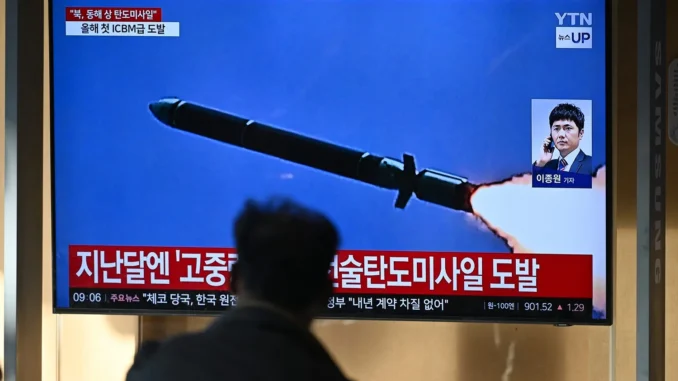
Leader Kim Jong Un painted the launch as a warning to Pyongyang’s enemies.
A Show of Strength
North Korea’s latest long-range missile test has the country’s Indo-Pacific neighbors and Western adversaries angry—and nervous. Pyongyang tested an intercontinental ballistic missile (ICBM) on Thursday, surpassing its previous flight time record to reach 87 minutes. Launched from near the country’s capital, the weapon traveled roughly 620 miles before splashing down just 125 miles west of Japan’s Okushiri Island.
According to Japan’s Defense Ministry, the missile launched at a “very high” angle, reaching an altitude of roughly 4,350 miles. This means that, in theory, the weapon could have flown much farther. North Korea’s last ICBM test in December 2023 flew for 73 minutes, translating to a potential range of around 9,320 miles on a normal trajectory and putting anywhere in the mainland United States within range of attack.
North Korean leader Kim Jong Un painted Thursday’s launch as a warning to Pyongyang’s enemies. However, U.S. National Security Council spokesperson Sean Savett said the test “did not pose an immediate threat to U.S. personnel, or territory, or to our allies.” Savett did, though, condemn the action as a “flagrant violation” of several United Nations Security Council resolutions. “It only demonstrates that [North Korea] continues to prioritize its unlawful weapons of mass destruction and ballistic missile programs over the well-being of its people,” he said in a statement.
Analysts viewed Pyongyang’s launch as a means of showing strength ahead of the U.S. presidential election next Tuesday. Japan and South Korea also condemned the test, with Seoul announcing new export controls on materials that North Korea needs to produce solid-fuel missiles. North Korea is estimated to have around 50 “stored” nuclear warheads, meaning they are not actively deployed.
South Korea has repeatedly warned against its neighbor’s growing military capabilities. It has specifically cited the more than 10,000 North Korean troops currently stationed in Russia as evidence that Pyongyang is helping Moscow to fight Ukraine in exchange for valuable combat experience and technology transfers—such as tactical nuclear weapons, ICBMs, ballistic missile submarines, and military reconnaissance satellites—that could threaten the Korean Peninsula.
The timing of Thursday’s launch also coincided with 2+2 meetings in Washington, where U.S. Secretary of State Antony Blinken and Defense Secretary Lloyd Austin met with their South Korean counterparts, Foreign Minister Cho Tae-yul and Defense Minister Kim Yong-hyun, to discuss Pyongyang’s emerging role in the Russia-Ukraine war.





